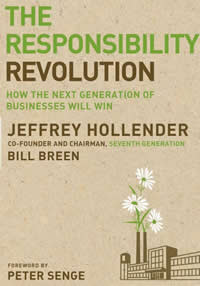Companies have been quietly embracing sustainability for years. Organic Valley ditched Wal-Mart as a customer in 2004 to maintain a livable wage for its farmers. Nike welcomes criticism of its offshore factories–and uses it as a catalyst to change factory conditions. IBM uses online crowdsourcing for its innovations.
The Responsibility Revolution: How the Next Generation of Businesses Will Win is full of engaging case studies like the ones above. Written by Seventh Generation CEO Jeffrey Hollender and veteran business writer Bill Breen, The Responsibility Revolution examines corporate responsibility in real world terms.
Through company stories, the book shows you what companies have done to successfully foster corporate responsibility (CR) and sustainability. You learn the six principles that work, as well as some that don’t (greenwashing, for example).
Rather than detailing CR’s “marketing pap,” as some books do, the Hollender and Breen show you what it takes to create an authentic, sustainable, collaborative corporation. Companies can use the principles mentioned above as guiding lights for the journey from profit monger to conscious corporation.
Inside the Book
The Responsibility Revolution starts by defining exactly what its namesake, the responsibility revolution, actually is. Then, the book dives into six “core principles” that it claims are the best way to help evolve responsibility. These are mission, collaboration, transparency, authenticity, community, and consciousness.
Each chapter covers a core principle. First, you learn why mission is important, and what a mission-driven company looks like. Next, the book covers how to build a community inside of your company.
The meaning and implementation of transparency follow, courtesy of Timberland, Patagonia, and Novo Nordisk case studies. After that, you learn how to cultivate authenticity instead of greenwashing. Next come collaboration and crowdsourcing, with an emphasis on how turning consumers into contributors gives companies a competitive advantage.
At the end, a lengthy Seventh Generation case study shows you what a corporate consciousness is, and how to create it. They bring the term “conscious corporation” down to earth, insofar as that’s possible. The book leaves you with a provocative question: “What does the world most need that you are uniquely able to provide?”
Thoughts
The Responsibility Revolution’s diverse, insightful company stories are its real strength. Each helps you comprehend the factors influencing a company’s actions. They make the book feel effortless.
The authors give a good high-level overview to help you understand corporate responsibility (CR). Clearly, CR isn’t as cut-and-dried as some “experts” might have you believe. The authors’ real life CR experience, especially Hollender’s, gives the book an authentic quality not found in some other books on the topic.
Hollender and Breen also do an excellent job of communicating the fact that CR involves many variables. They don’t shirk ambiguity, but instead endeavor to incorporate it into CR’s fold. That’s a realistic approach. But it takes patience and an open mind to really absorb that kind of content as a reader.
I’d recommend this book for business types, particularly high-level thinkers like executives and consultants. It’s not an entry-level read on CR. If you’re new to the topic, or you want an easy overview, I’d suggest starting somewhere else. If you want more intimacy with CR, and a progressive look at the topic, do pick up this book.
Disclosure: We received a free copy of The Responsibility Revolution.

